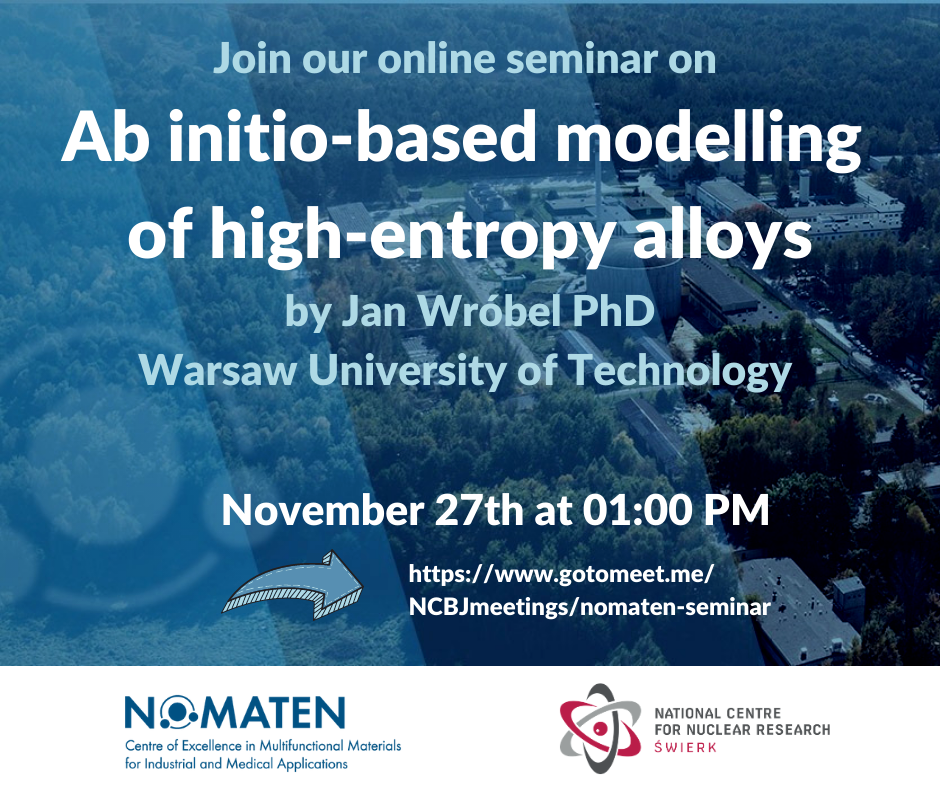NOMATEN's online seminar: Ab initio-based modelling of high entropy alloys by Jan Wróbel PhD Warsaw University of Technology (NOV 27th at 01:00 PM)
Join the seminar on November 27th at 01:00PM via GoToMeeting
https://www.gotomeet.me/NCBJmeetings/nomaten-seminar
Ab initio-based modelling of high-entropy alloys
Jan S. Wróbel PhD
Faculty of Materials Science and Engineering, Warsaw University of Technology
High entropy alloys (HEAs) are the new class of materials with unique microstructure and properties. They contain four or more components in equal or near-equal atomic percent. The high configurational entropy associated with mixing several elements inhibits the formation of brittle intermetallic phases in favour of multicomponent random solid solutions. Due to their high yield strength and hardness at elevated temperatures, HEAs are potential candidates for high-temperature applications whereas their superior irradiation properties in comparison with pure elements and conventional alloys make them potential candidates for applications in structural elements of future fusion and fission reactors.
Due to the enormous number of combinations of components and their concentrations, the experimental investigation of all combinations is impossible. Therefore, the theoretical understanding of the influence of components and their concentrations on the phase stability and basic properties of HEAs is very important. Among possible computational modelling techniques, the ab initio method based on the density functional theory (DFT) is the most desirable for the modelling of multicomponent alloys. The main advantage of this method is that the experimental data are not needed to predict the properties of materials. The main shortcoming of this method is that it is time-consuming and therefore the maximum number of atoms is quite limited and thus it is usually required to combine DFT with other higher-scale methods.
In this seminar, I will review the chosen DFT-based methods. Especially, I will focus on the combination of DFT, the cluster expansion method and Monte Carlo (MC) simulations, which can be applied to understand interactions in the alloys, to investigate the phase stability of alloys as a function temperature and alloy composition and to generate the representative structures for further DFT calculations. On the example of non-magnetic bcc Cr-Ta-Ti-V-W and magnetic fcc Fe-Cr-Mn-Ni alloys, I will present how the short-range ordering and order-disorder transition temperature depend on the concentration of elements and how this can be used to design novel alloys with improved homogeneity of atoms. The DFT-based MC simulations were validated positively by experiments. In agreement with theoretical results, the sample of Ta-Ti-V-W synthesised using arc-melting was the disordered solid solution whereas in others there were observed precipitations. The experiments performed in collaboration with NCBJ showed that Ta-Ti-V-W alloy possesses also very good irradiation properties.
Next, I will discuss the role of point defects and impurities in alloys and theoretical methods that can be applied to study them. Finally, I will present the methodology of the development of interatomic potentials for molecular dynamics simulations by using the combination of DFT and machine learning method, which is the topic of my current project.
Jan S. Wróbel PhD, Faculty of Materials Science and Engineering, Warsaw University of Technology
Dr Jan Wróbel is an Assistant Professor at the Faculty of Materials Science and Engineering (FMSE), Warsaw University of Technology (WUT). His research focuses on the ab initio modelling of materials properties based on the density functional theory (DFT). He was using this method both for his Master's thesis at the Faculty of Physics WUT and PhD thesis at FMSE-WUT. After a defence of his PhD thesis in June 2012, Dr Jan Wróbel moved for a post-doc to the world-renowned Materials Modelling group head by Prof. Sergei Dudarev at Culham Centre for Fusion Energy in the United Kingdom, where he was involved during 2.5 years in the Accelerated Metallurgy project. In this project, he was responsible together with Prof. Duc Nguyen-Manh for the DFT modelling of phase stability of multicomponent alloys for fusion applications.
After his come back to Poland, Dr Jan Wróbel was the project leader of the HOMING project titled “Ab-initio modelling of phase stability and properties of high-entropy alloys” financed by the Foundation for Polish Science. Now, he is the principal investigator of the SONATA project titled “Microstructure evolution of Ta-Ti-V-W high-entropy alloys: from ab initio modelling to additive manufacturing technology” supported by the National Science Foundation in Poland. Since the year 2017, he has been also the task leader within the IREMEV (Irradiation Effects Modelling and Experimental Validation) package in the EUROfusion project.
Dr Jan Wróbel is an author of 31 papers (8 of them are focused on high-entropy alloys) in international journals with peer reviewers that have more than 500 citations. The Hirsch index of Dr Jan Wróbel is 13. He won the Scholarship for Young Scientists funded by the Foundation for Polish Science. Dr Jan Wróbel was a visiting scientist and a member of the “Materials for Fusion and Fission” group at the Materials Department of University of Oxford head by Prof. Steve Roberts. He has completed also an internship in the group of Prof. Georg Kresse at the University of Vienna, in which the VASP code (the most popular program for DFT calculations) was created and is being now developed.







